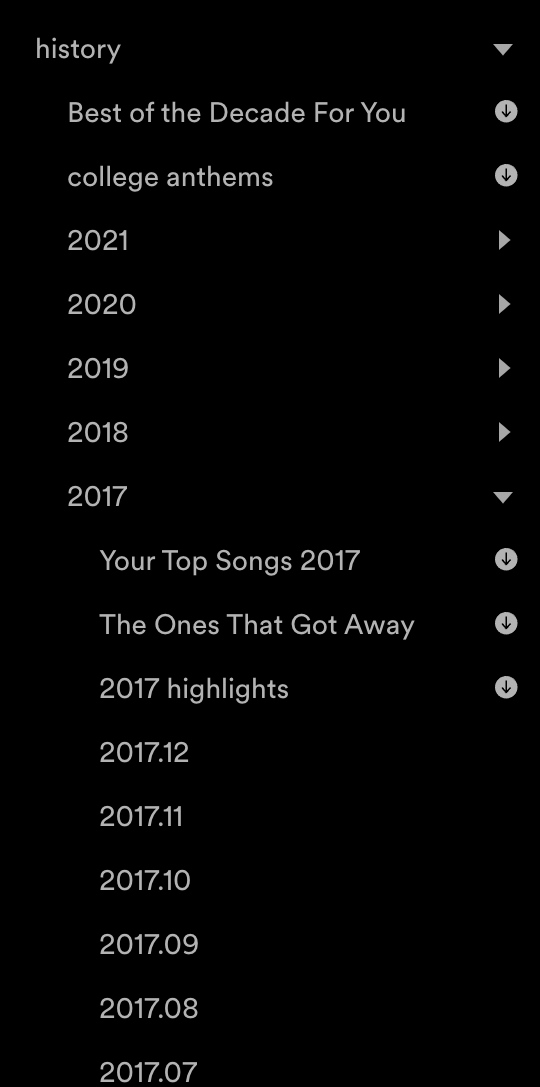Playlists
A collection of my Spotify playlists, with some commentary.
# Gallery
Last queried from Spotify in Jan 2022.
Most recent first:
# More than you wanted to know
This is a look into some of the ways I’ve thought about making playlists over the years. If you see something that resonates with you, I’d love to discuss.
# As a flow
Most of my playlists are like traditional mixtapes—inspired by some central idea, and arranged in a particular order. A few examples:
“hang the dj” is a collection of 80s new-wave.
“saguaro crestado” captures how I feel driving through the Arizona desert at sunset.1
“painted paradise” explores abstractions of the blues, across a variety of eras, genres, and regional styles.
Once the theme picks up momentum, I spend a lot of time thinking about the flow of a playlist. The flow has a range of scope—from the specific moment of transition between songs, all the way to the broader shift in atmosphere over many songs. I think finding a good sequence is a lot like finding a smooth gradient.
Say you have five songs in roughly the same “genre”:
They all have this gentle and upbeat characteristic to them, which was the original motivation for grouping them together. But they each have their own unique hue and emotion.
I think there’s something immensely gratifying about finding this order:
Of course, musical space is much more subjective and abstract than color space. And in reality, songs are more like gradients than solids, and playlists are more like winding paths than linear functions.
As with good design, the flow is often least noticeable at its best. There can be room for a certain jazzy sprezzatura, but it’s easy for tasteful surprisal to slip into discordance.
It’s worth noting that my older playlists tend to be more like unordered collections—longer, broader, and more convenient to throw on shuffle for extended periods of time. But I’ve trended away from these over the years. They’re less fun to make, and it’s gotten easier to find radio stations and other mixes on Spotify for this purpose.
# As a story
I’ve also experimented with a more narrative format. In these playlists, the lyrics fit together into a broad-strokes story—each song becoming a snippet in the tale of some fictional character I’ve dreamt up. The musical congruence is still important, but there’s a particular focus on what each artist is trying to say.
I started doing this as a way to make sense of significant life experiences. Music has always been a powerful way for me to explore my emotions, ever since my angsty middle school days listening to “Breakaway” by Kelly Clarkson.
I’ve only made two, and I don’t think it’s a coincidence that both emerged at crossroads in my life, during periods of considerable reflection and uncertainty (and free time):
“and miles to go” is a sort of spiritual rendering of the PCT. It’s about journeys—questioning, setting forth, and the rollercoaster of love and loss along the way. Then, after everything is said and done, deciding to sail into the mystic for more.
“we can be heroes” emerged in the days leading up to my college graduation. It’s about coming to grips with the tides that bring us together and pull us apart. For good times and good byes.
# As a journal
I was an iTunes power user for many years, amassing a library of about 25,000 songs. These are now collecting dust on an external hard drive somewhere, which I may never turn on. I shudder to think of how much time I spent downloading music in high school.2
When I finally got on the Spotify train, I couldn’t get used to the “Liked Songs” framework, and struggled to reliably download songs offline. So I started making a temporary playlist for each month, to make discoveries more accessible. Whenever I found something new that stood out to me, I’d add it to that month’s playlist.
Eventually I got used to Spotify, but I ended up sticking with this habit. It turned out to be pretty neat to be able to “go back in time” and peek into the musical milieu of a given time period—I’ve always had strong associations between music and memories. At this point, I have over 5 years of monthly history.3
This is what it looks like—by year and month, with some additional compilations:

At some point, I plan to add some additional visualizations here.
-
The cover photo is not, in fact, a crested saguaro. I never saw one while living in Tucson, but something about the unrealized search seemed to fit the theme well. ↩
-
If you work for the DMCA, what I mean to say is that I spent a lot of time buying songs with iTunes gift certificates. ↩
-
To Spotify: it would be nice if you exposed historical plays through the Web API, or allowed users request a download of their play history. I’d even write the Spark query myself. ↩
































